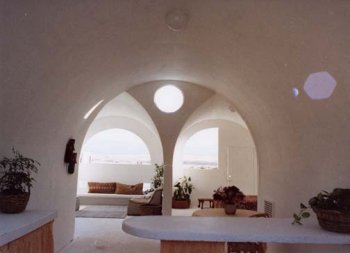earth-sheltered home damp-proofing

Various damp-proofing methods are appropriate for use in earth-sheltered homes. Damp-proofing products are those which will interrupt the capillary draw of moisture into the walls of a building but are either too thin, have too little resistance to bridging wall cracks, or deteriorate too easily to be considered as a good waterproofing technique. Although damp-proofing can help dampness problems in many instances, there are no guarantees with it. It is not intended to stop water penetration and hence there is almost no comeback for a system that doesn't work. Some of the techniques are discussed below.
Concrete mix design and additives
There is much that can be done to make concrete more impermeable than it normally is, including keeping the water/cement ratio as low as possible, using adequate vibration when placing the concrete and including well distributed reinforcement to limit the size of the shrinkage cracks that occur when the concrete dries out. Admixtures can fill the capillary channels in the concrete, others react when they come into contact with water. All these techniques will cut down the permeability of the wall, but as long as concrete cracks and shrinks when it dries, which is always the case (unless very expensive expansive cements are used), cracks will occur which destroy the integrity of the seal. For limiting the flow through the wall which is the primary goal in reservoirs, for example, the techniques can be very successful but even very small amounts of leakage can make unsightly marks on the wall, roof, or floor finishes.
Pargeting
This refers to the coating of the wall with a dense cement plaster or similar material. This can be done on the inside or the outside of the wall, but as with all waterproofing applications it is best done on the outside of the wall so that any water pressure will not tend to force the coating off the wall and so that the wall will be on the dry side of the waterproofing (particularly important when reinforcing steel is contained in the wall because if it were on the wet side of the waterproofing it could then rust and spall the concrete). Cracking of the wall which almost inevitably occurs will also crack these generally brittle materials, and hence, they cannot be relied on as waterproofing materials.
Asphalt coating
These can be used applied hot or cold and can be sprayed, brushed, or trowelled on. In general, trowelling gives a better job than spraying because a denser layer with better adhesion is obtained. Hot asphalt applications become brittle when they cool and the cold asphalt applications have some bridging characteristics over cracks but not sufficient to bridge normal sized structural cracks. Asphalt emulsions are slowly soluble in water.
Pitch
This is a more stable material to use underground than an asphalt emulsion. A special waterproofing pitch used to be available but was discontinued to comply with health standards of fume release during application. The major pitch available now is a general purpose pitch designed for roofing applications. It has a softening point of about 150°F and hence underground it will remain brittle with no resealing abilities.
Polyethylene sheet
This is a very cheap material use. It degrades when exposed to sunlight but when completely covered underground it should last a long time. With reasonable laps and care taken not to puncture the sheet during placement and backfilling it will function as good barrier against capillary draw and vapor transmission. No attempt is usually made to seal the laps completely and hence it will not resist a water pressure on its own. It does have the capability of bridging some cracking in the concrete. For the floor of an earth-sheltered house that is above the water table, has a foundation drain system and gravel layer under the floor, this type of damp-proofing protection will usually be adequate.
Liquid seals
These suffer from the same problems as most damp-proofing techniques. When the walls crack the integrity of the seal goes with it.
